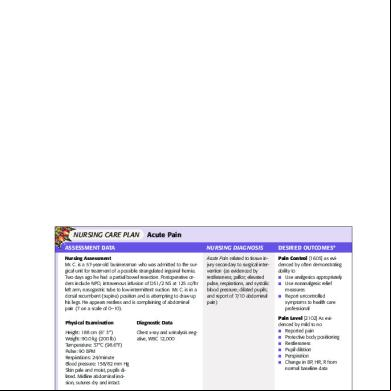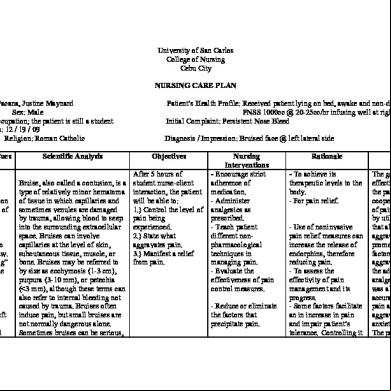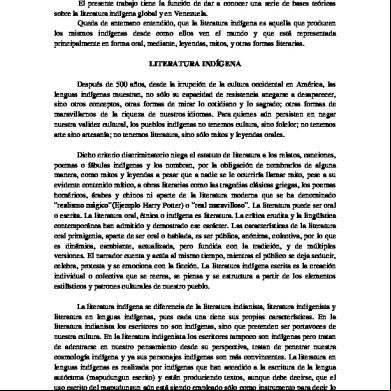Acute Pain Care Plan 22r30
This document was ed by and they confirmed that they have the permission to share it. If you are author or own the copyright of this book, please report to us by using this report form. Report 3b7i
Overview 3e4r5l
& View Acute Pain Care Plan as PDF for free.
More details w3441
- Words: 384
- Pages: 2
UNIVERSITY OF NORTH ALABAMA COLLEGE OF NURSING ADULT HEALTH NURSING 1 - NU 304 DATE OF CLINICAL EXPERIENCE: 10/11/10
NURSING PROCESS FORM
STUDENT’S NAME: Kim
Biro
Nursing Diagnosis
Goals (Planning) (3)
Nursing Interventions
Rationale for Interventions * must list sources
Evaluation of Goals
Acute Pain related to abdominal surgical incision AEB verbal reports of pain, grimacing, moaning, and guarding of abdominal area when assessed.
Given the prescribed nursing care, the patient will have relieved/controlled pain within one hour AEB:
1) Assess patient’s pain including: location, onset/duration, frequency, quality, and intensity using a pain scale of 0-10 every two hours.
1) To ensure that a patient receives effective pain relief, you must conduct a thorough and accurate pain assessment. (Lippincott, Williams & Wilkins, pg. 361)
Goal was met.
1. Patient verbally states relieved/decreased pain. 2. Nonverbal indicators of pain including grimacing and moaning will be absent/diminished.
2) Monitor patient’s vital signs for signs of pain including: increased heart rate, blood pressure, and respiratory rate every two hours.
3. Patient will not guard abdominal incision area during assessment. 3) Observe patient for nonverbal indicators of pain including: facial grimacing, moaning, guarding, and crying during assessment of pain and vital signs.
Resources: Swearingen, Pamela. (2008). All-in-One Care Planning Resource. (2nd Edition). St. Louis, MO: Mosby, Inc. Lippincott, Williams & Wilkins. (2006). Best of Incredibly Easy! (1st Edition). Philadelphia, PA:
4) ister prescribed analgesics as ordered by physician, monitor the patient’s response to pain medication 5-10 minutes after istration, and document appropriately when given. 5) Provide and teach caregivers non-pharmacologic comfort measures including repositioning and creating a low stimulus
2) Acute pain activates the sympathetic branch of the ANS causing such responses as increasing blood pressure, and rapid heart and respiratory rates. (Lippincott, Williams & Wilkins, pg. 362) 3) Behavioral and physiologic responses are indicators of pain in patients. (Searingen, pg. 40) 4) Analgesics are helpful in relieving pain and in aiding the recovery process by promoting greater ventilator excursion. (Swearingen, pg. 423) 5) Non-
1. Patient verbally reported decreased pain as being “much better.” 2. Nonverbal indicators of pain were absent upon observation. 3. Patient did not guard abdominal incision area upon assessment.
Wolters Kluwer, Co.
REV 8/09
environment when patient reports pain prior to discharge.
pharmacologic measures analgesia therapy in reducing pain. (Swearingen, pg. 423)
NURSING PROCESS FORM
STUDENT’S NAME: Kim
Biro
Nursing Diagnosis
Goals (Planning) (3)
Nursing Interventions
Rationale for Interventions * must list sources
Evaluation of Goals
Acute Pain related to abdominal surgical incision AEB verbal reports of pain, grimacing, moaning, and guarding of abdominal area when assessed.
Given the prescribed nursing care, the patient will have relieved/controlled pain within one hour AEB:
1) Assess patient’s pain including: location, onset/duration, frequency, quality, and intensity using a pain scale of 0-10 every two hours.
1) To ensure that a patient receives effective pain relief, you must conduct a thorough and accurate pain assessment. (Lippincott, Williams & Wilkins, pg. 361)
Goal was met.
1. Patient verbally states relieved/decreased pain. 2. Nonverbal indicators of pain including grimacing and moaning will be absent/diminished.
2) Monitor patient’s vital signs for signs of pain including: increased heart rate, blood pressure, and respiratory rate every two hours.
3. Patient will not guard abdominal incision area during assessment. 3) Observe patient for nonverbal indicators of pain including: facial grimacing, moaning, guarding, and crying during assessment of pain and vital signs.
Resources: Swearingen, Pamela. (2008). All-in-One Care Planning Resource. (2nd Edition). St. Louis, MO: Mosby, Inc. Lippincott, Williams & Wilkins. (2006). Best of Incredibly Easy! (1st Edition). Philadelphia, PA:
4) ister prescribed analgesics as ordered by physician, monitor the patient’s response to pain medication 5-10 minutes after istration, and document appropriately when given. 5) Provide and teach caregivers non-pharmacologic comfort measures including repositioning and creating a low stimulus
2) Acute pain activates the sympathetic branch of the ANS causing such responses as increasing blood pressure, and rapid heart and respiratory rates. (Lippincott, Williams & Wilkins, pg. 362) 3) Behavioral and physiologic responses are indicators of pain in patients. (Searingen, pg. 40) 4) Analgesics are helpful in relieving pain and in aiding the recovery process by promoting greater ventilator excursion. (Swearingen, pg. 423) 5) Non-
1. Patient verbally reported decreased pain as being “much better.” 2. Nonverbal indicators of pain were absent upon observation. 3. Patient did not guard abdominal incision area upon assessment.
Wolters Kluwer, Co.
REV 8/09
environment when patient reports pain prior to discharge.
pharmacologic measures analgesia therapy in reducing pain. (Swearingen, pg. 423)










